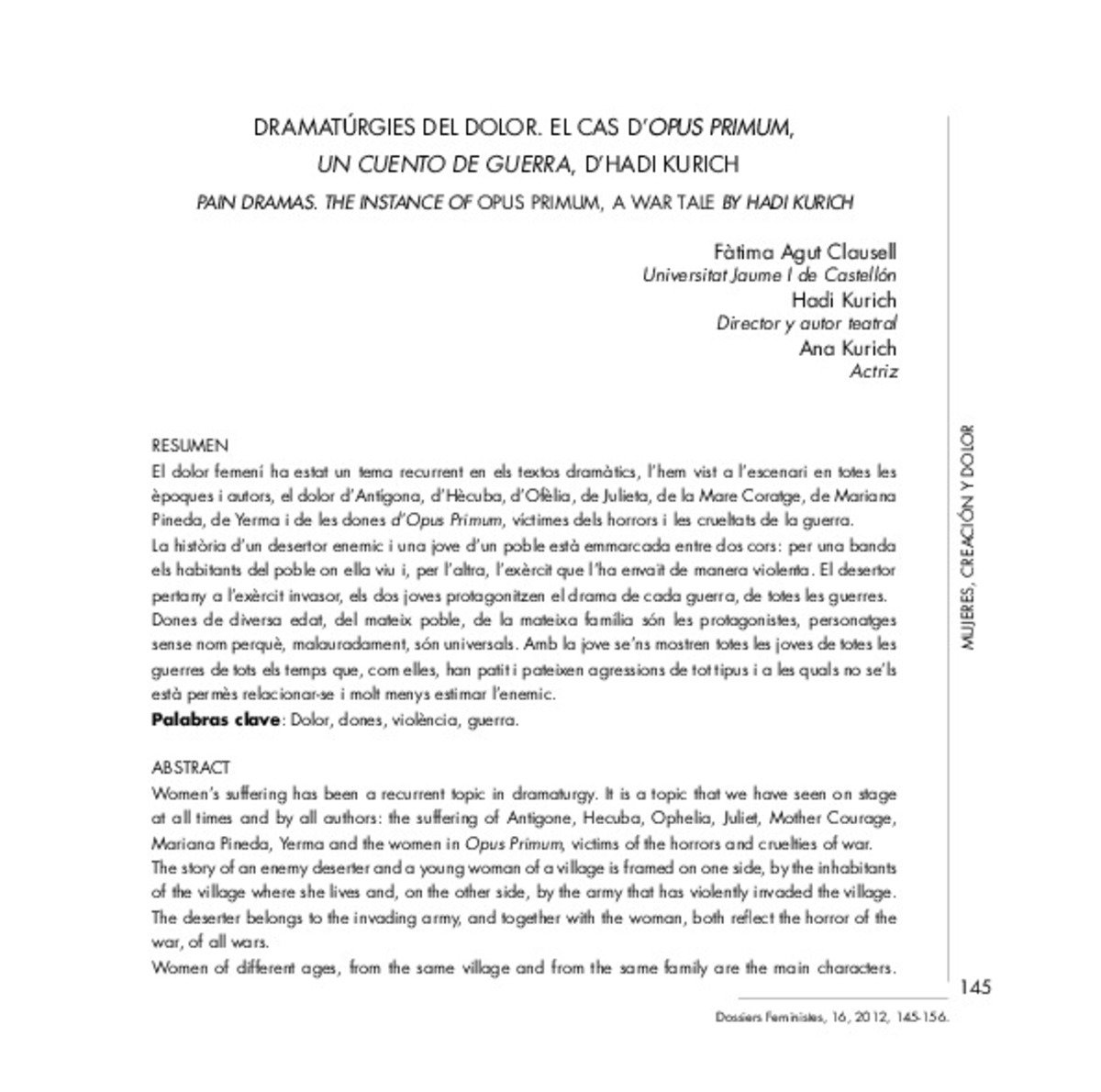Mostrar el registro sencillo del ítem
DRAMATÚRGIES DEL DOLOR. EL CAS D’OPUS PRIMUM, UN CUENTO DE GUERRA, D’HADI KURICH
| dc.contributor.author | Agut i Clausell, Fàtima | |
| dc.date.accessioned | 2015-11-18T08:25:57Z | |
| dc.date.available | 2015-11-18T08:25:57Z | |
| dc.date.issued | 2012 | |
| dc.identifier.issn | 1139-1219 | |
| dc.identifier.issn | 2340-4930 | |
| dc.identifier.uri | http://hdl.handle.net/10234/140565 | |
| dc.description.abstract | El dolor femení ha estat un tema recurrent en els textos dramàtics, l’hem vist a l’escenari en totes les èpoques i autors, el dolor d’Antígona, d’Hècuba, d’Ofèlia, de Julieta, de la Mare Coratge, de Mariana Pineda, de Yerma i de les dones d’Opus Primum, víctimes dels horrors i les crueltats de la guerra. La història d’un desertor enemic i una jove d’un poble està emmarcada entre dos cors: per una banda els habitants del poble on ella viu i, per l’altra, l’exèrcit que l’ha envaït de manera violenta. El desertor pertany a l’exèrcit invasor, els dos joves protagonitzen el drama de cada guerra, de totes les guerres. Dones de diversa edat, del mateix poble, de la mateixa família són les protagonistes, personatges sense nom perquè, malauradament, són universals. Amb la jove se’ns mostren totes les joves de totes les guerres de tots els temps que, com elles, han patit i pateixen agressions de tot tipus i a les quals no se’ls està permès relacionar-se i molt menys estimar l’enemic. | ca_CA |
| dc.description.abstract | Women’s suffering has been a recurrent topic in dramaturgy. It is a topic that we have seen on stage at all times and by all authors: the suffering of Antigone, Hecuba, Ophelia, Juliet, Mother Courage, Mariana Pineda, Yerma and the women in Opus Primum, victims of the horrors and cruelties of war. The story of an enemy deserter and a young woman of a village is framed on one side, by the inhabitants of the village where she lives and, on the other side, by the army that has violently invaded the village. The deserter belongs to the invading army, and together with the woman, both reflect the horror of the war, of all wars. Women of different ages, from the same village and from the same family are the main characters. All of them are characters without name because, unfortunately, they are universal characters. The young woman is a mirror of all young women of all wars and conflicts of all times. Women that, like her, have suffered and are suffering aggressions of all types and for which it is absolutely forbidden to love the enemy | ca_CA |
| dc.format.mimetype | application/pdf | ca_CA |
| dc.language.iso | cat | ca_CA |
| dc.publisher | Universitat Jaume I. Institut Universitari d' Estudis Feministes i de Gènere | ca_CA |
| dc.relation.isPartOf | Dossiers feministes; Núm.: 16 | ca_CA |
| dc.rights.uri | http://rightsstatements.org/vocab/CNE/1.0/ | * |
| dc.subject | dolor | ca_CA |
| dc.subject | dones | ca_CA |
| dc.subject | violència | ca_CA |
| dc.subject | guerra | ca_CA |
| dc.subject | suffering | ca_CA |
| dc.subject | women | ca_CA |
| dc.subject | violence | ca_CA |
| dc.subject | war | ca_CA |
| dc.subject.other | Dones -- Revistes | ca_CA |
| dc.subject.other | Feminisme -- Revistes | ca_CA |
| dc.title | DRAMATÚRGIES DEL DOLOR. EL CAS D’OPUS PRIMUM, UN CUENTO DE GUERRA, D’HADI KURICH | ca_CA |
| dc.title.alternative | PAIN DRAMAS. THE INSTANCE OF OPUS PRIMUM, A WAR TALE BY HADI KURICH | ca_CA |
| dc.type | info:eu-repo/semantics/article | ca_CA |
| dc.rights.accessRights | info:eu-repo/semantics/openAccess | ca_CA |
| dc.relation.publisherVersion | http://www.e-revistes.uji.es/index.php/dossiers/article/view/1201/1076 | ca_CA |







